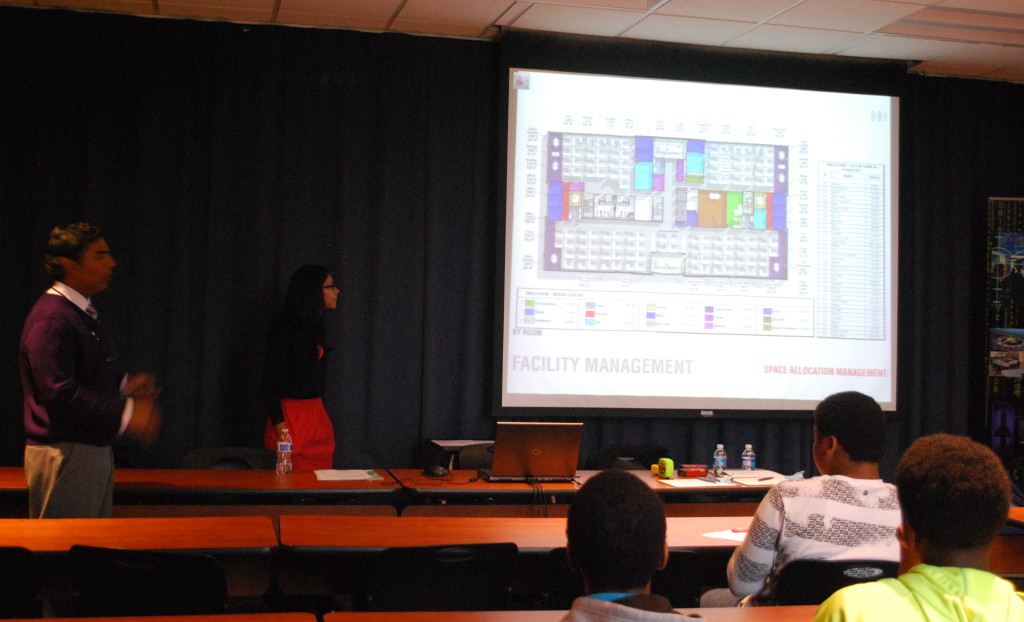In an ongoing effort to elevate student interest in the technological design industry, DBI participated in Fort Meade Alliance’s Tech Mania event held at Towson University on April 30. Directors Raj Banga and Jack Bajadek, as well as Interior Designer Farihah Saleem, presented an overview of building information modeling (BIM) to more than 150 ninth-grade students from several central Maryland school districts, including Baltimore and Harford Counties and Baltimore City.
The Fort Meade Alliance, a non-profit collaboration between Fort George G. Meade and regional businesses, organizations, and federal agencies, stimulates economic interest in the area by offering a variety of business development initiatives and educational programs. The Tech Mania program aims to expand regional students’ awareness of STEM (science, technology, engineering, and mathematics) educational opportunities, as well as the myriad career paths available to college graduates with degrees in STEM fields. Considering that the Fort Meade region is a hub of military, scientific, and industrial operations—and that the U.S. workforce continues to experience a critical shortage of highly qualified STEM professionals, the Alliance’s outreach to area students is a judicious and vital endeavor. At the annual Tech Mania event, which first took place in April 2008, representatives from area businesses, federal agencies, and colleges discuss their real-world, on-the-job experience with the innovative technologies that industries currently use to tackle complex problems.
During a series of 30-minute presentations, DBI introduced BIM design technology to groups of students, who rotated through the extensive array of informative sessions offered by regional businesses and industry professionals. To illustrate BIM’s architectural applications, the DBI team presented several case studies demonstrating the software’s importance as a vast repository of detailed, project-specific data that contains and analyzes various types of information about a project’s entire life cycle—from conceptual design to building management. DBI also emphasized that students who pursue careers in architecture, or in any design industry, will be expected to have in-depth knowledge of sophisticated modeling technologies like BIM. Describing the universal application of information modeling technology, Raj explains, “Our demonstration focused on the AEC/O industry, but any design industry—whether industrial engineering, fashion design, or manufacturing—is going to make use of this technology or something similar.” In addition, Jack illustrates how all of the disciplines that benefit from information modeling are making use of the same fundamental process:
“Anything that is of a design basis is really using technology as a platform for discovery, innovation, and experimentation…and for metrics and data-gathering. It’s all those aspects that are computerized and put into a virtual model, so that it is a medium by which students can learn, and engineers can experiment. Anything can be designed from the virtual aspect of modeling and gathering information, then taking that information and asking, “How do we produce this?” It’s a sequence of steps.”
During a recent related discussion, Farihah also remarked that this technology is becoming an indispensable tool within the field, empowering not only designers but the entire multi-disciplinary project team and their clients. She views BIM as “a gateway software” that offers a central hub of information with unmatched integration capabilities.
The students, after their introduction to BIM, had the opportunity to participate in a hands-on activity that demonstrated basic modeling concepts. They surveyed their classroom, entered measurements into Autodesk’s Revit program, and, then, designed three-dimensional models of university rooms. The demonstration appealed to many students, who eagerly asked questions about the technology’s capabilities. Encouraged by the enthusiastic reception—and delighted to have been a part of Tech Mania 2014, DBI is brainstorming about how to create an even more compelling hands-on presentation for next year’s event.
Proud to be a member of the Fort Meade Alliance, DBI is an industry leader in the implementation of architectural design technology and is committed to the continuing advancement of our technological resources. We maintain a carefully planned, state-of-the-art, and integrated design platform, which enables us to convey conceptual designs quickly and in great detail, thereby increasing our team’s productivity and facilitating better-informed decisions by our clients. Our team creates cutting-edge designs for all types of spaces—from specialty suites, to entire office buildings, to stealth-oriented secure sites, such as data centers, advanced concept laboratories, and government facilities.


